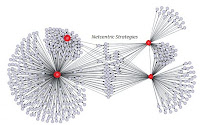I read a very interesting article in BusinessWeek (February 9, 2010 edition) today called "What SAP Needs After Apotheker" by Aaron Ricadela. Last week, as many of you know, Leo Apotheker was replaced as CEO of SAP by both Bill McDermott and Jim Hagemann Snabe who were announced as Co-CEOs. In the article SAP mobility is raised again and again as an area where improvements are needed. Here is an excerpt, "In order to fix SAP, former North American sales boss McDermott and Snabe, head of product development, need to stock its pipeline with products that companies are more interested in buying… SAP must develop versions of its complicated software that can be delivered over the Internet and run on new classes of mobile computing devices."
In December of 2009, SAP unfolded their 5-year strategic plan that emphasized the following five points: on-demand computing, cloud architectures, flexible pricing, mobile and in-memory computing. This event was covered well by InformationWeek in an article called SAP Outlines 5-Year Enterprise Software Plan. I assume this 5 year plan announced in December was developed by Snabe and his team, so Apotheker's departure is unlikely to change this emphasis.
Don Bulmer, SAP VP of industry relations is also quoted at a recent Influencer Summit in Boston saying, "Sixty to seventy percent of the population has mobile devices… There are lots of opportunities for SAP." This seems to back repeated comments from SAP executives that they recognize the importance of mobility.
Here is another excerpt from BusinessWeek, "SAP needs to articulate to customers a clearer plan for delivering new technologies that can save money and make workers more productive, says Forrester analyst Hamerman." He goes on to add, "the company (SAP) must deliver more software over the Web and let users interact more capably with it through smartphones and tablets...Those are on the road map but they don't seem to be a priority...We haven't seen from them (SAP) a comprehensive technology strategy."
Hamerman does not seem to feel a listing in the 5 year enterprise software plan is sufficient. He wants to see a comprehensive technology strategy and a demonstration that mobility is a priority.
More from BusinessWeek, "Additional announcements of SAP software for cloud computing and mobile devices will come later this year, according to a person close to SAP. To get the message across, Plattner (Hasso Plattner, SAP co-founder) even plans to deliver his keynote address in Orlando with the help of an Apple iPad."
McDermott also tried to communicate that mobility was a SAP priority with the following announcement, "SAP plans to announce new online software under the Business By Design brand name for customer management, human resources, and procurement. Once it arrives in the second half of this year, customers will be able to run the software on their own servers, access it through the Web, and run portions of it on mobile devices."
In summary, SAP says mobility is one of the 5 key points in their strategic 5-Year Enterprise Software Plan. SAP's new Co-CEOs have reiterated that mobility is a high priority. Don Bulmer, SAP VP of industry relations agrees that there are lots of opportunities for SAP in mobility. Forrester analyst Hamerman says that it is not enough to say it, "Show me the money!" SAP Co-Founder Hasso Plattner says, "OK, watch me do a Sapphire power point on an iPad."
Here is another challenge – SAP has announced multiple reseller and co-innovation agreements with mobile solutions companies like Sky Technologies, RIM, Sybase, Syclo and ClickSoftware. So a customer looking for mobile solutions on SAP's EcoHub will find a plethora of mobile software solutions. In fact, mobile solutions for just about any need.
If I am looking for a good mobile enterprise application platform to work with SAP, I will find the following; Sybase for mobile Field Sales (except RIM users who can use RIM's mobile SAP CRM or Sky Technologies customers who can use their mobile version of SAP CRM?), Syclo for mobile field services, ClickSoftware for mobile route optimization, Sky Technologies for companies wanting to standardize on SAP embedded code? Is that clear to you? No, me neither.
Gartner analysts are suggesting that large enterprises should reduce the number of mobile application vendors. Read the following excerpt from Gartner's Magic Quadrant for Mobile Enterprise Application Platforms published December 16, 2009. "Enterprises are increasingly mixing solutions from multiple vendors, each with separate software stacks for data transport (which results in poor battery life). This also leads to conflicts with managing network connections on mobile devices, an inability to administer security and devices, complexities with testing, an increase in software defects, and higher service and support costs."
It will be very interesting to watch how SAP maneuvers the mobility landscape in 2010. Will SAP leave the task of bringing order out of chaos to third-party MEAP vendors, or will they?








